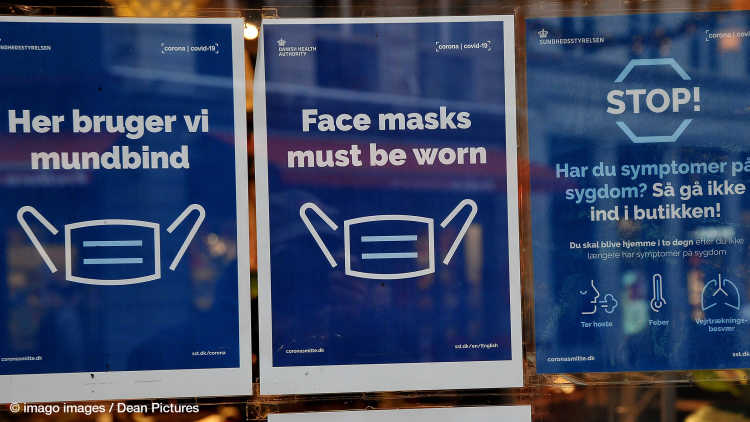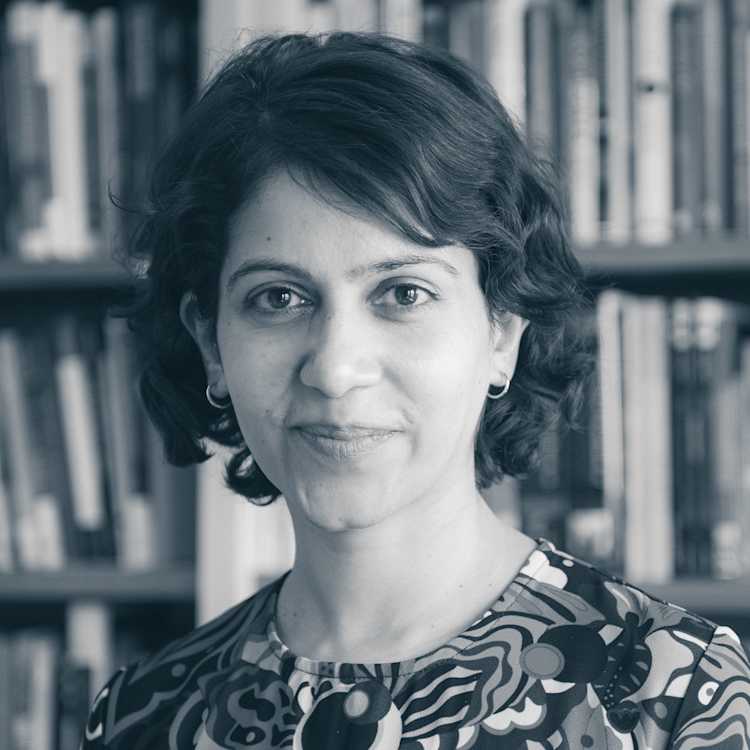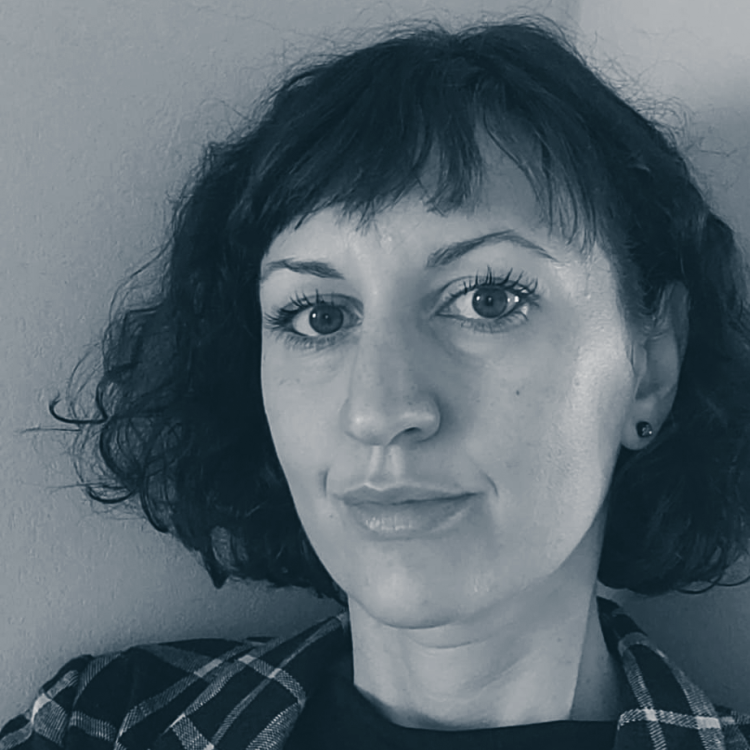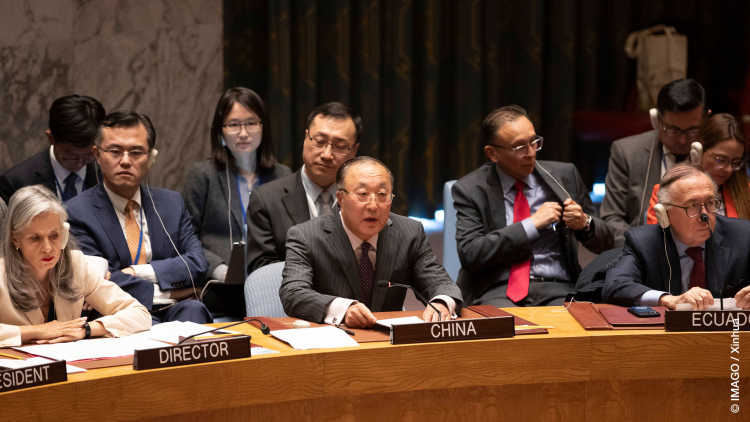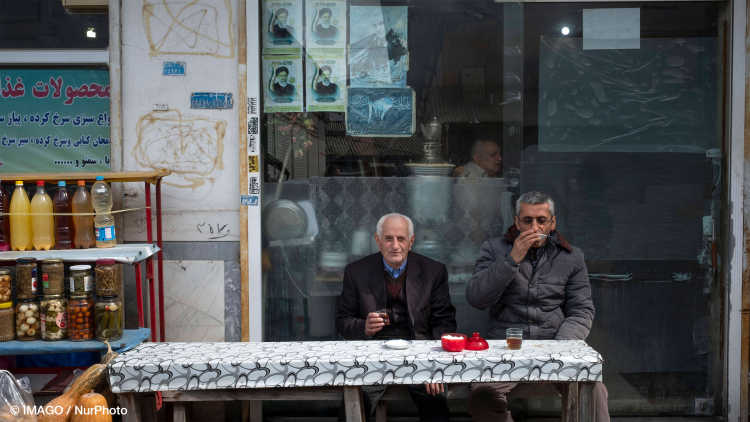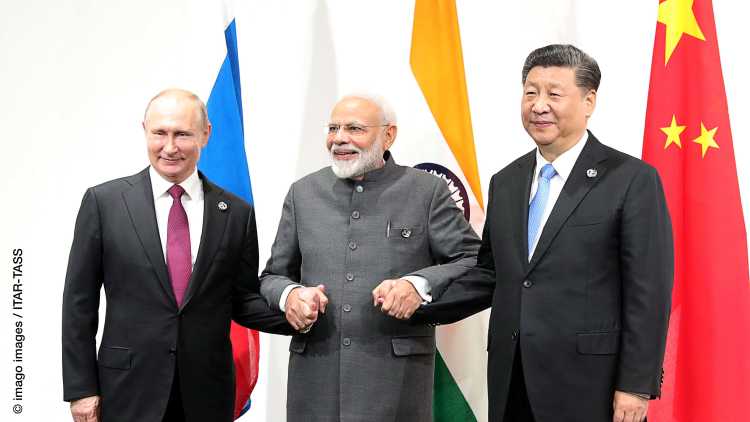- Home
- Publications
- GIGA Focus
- Raisi’s Foreign Policy: Pragmatic Revolutionism and the Iranian Pivot to Asia
GIGA Focus Middle East
Raisi’s Foreign Policy: Pragmatic Revolutionism and the Iranian Pivot to Asia
Number 7 | 2021 | ISSN: 1862-3611
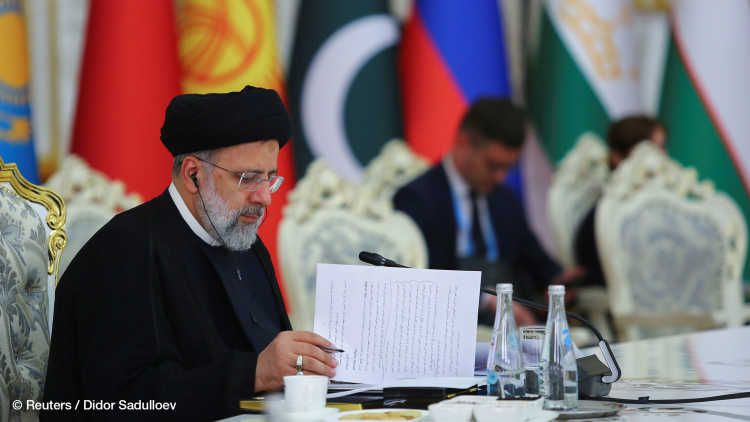
Sayyid Ebrahim Raisi, the new Iranian conservative president, has been in office for over four months now. Understanding his presidency matters for myriad reasons, including its historical significance, his foreign policy oriented towards Asia, and what the Iranian pivot to Asia under him entails geopolitically and geoeconomically.
Iranian conservative elites view the present moment as the end of the first phase of the Iranian Islamic revolution. Raisi’s presidency, to them, is the dawn of a historical “second phase”, a post–Ali Khamenei era for a young revolutionary generation.
Doctrinally, Raisi’s foreign policy can be described as “pragmatic revolutionism.” Policy-wise, Raisi – following Khamenei’s edict – is embracing the “Iranian pivot to Asia,” both geopolitically and geoeconomically.
Geopolitically, the revolutionary aspect of this pivot means supporting the resistance axis against the United States and Israel and expelling US forces from the region. Its pragmatism includes promoting regional solutions to regional problems, de-escalation with traditional rivals (e.g. the Emiratis, Saudis, Taliban), and further strategic proximity to Asian actors such as China.
Geoeconomically, the revolutionary dimension of this pivot is the resistance economy, a reactive policy to bypass US sanctions. The pragmatic multilateralist dimension is the Iranian connectivity strategy, a proactive process to make Iran a crossroads between various (Eur)Asian geoeconomic initiatives, such as China’s Belt and Road Initiative and International North-South Transport Corridor.
Policy Implications
If the West only concerns itself with the revolutionary component of Iranian foreign policy the costs will be too high. European and US policymakers should therefore seize upon the multilateralist and pragmatic tendencies of Raisi’s emerging foreign policy to revive the nuclear deal, with a focus on economic incentives. The European Union should strive for strategic autonomy to deal with Iran independently, if need be.
Ayatollah Ali Khamenei’s “Second Phase” of the Revolution
Based on Sayyid Ebrahim Raisi’s ideological and political background, presidential campaign, and his time as president, it is safe to argue that his political worldview is intimately aligned with that of the Iranian Supreme Leader, Ayatollah Khamenei, who sets the strategic priorities for Iran’s political elites. Khamenei views the contemporary era as a transitional moment. Internationally, he sees a world order transitioning from United States unilateralism to multipolarity, defined by the rise of Asian powers such as China and regional powers such as Iran. Other elites share his view. Mohammad Javad Zarif, former foreign minister (2013–2021), calls this moment the “post-Western international order” (Zarif 2016). Khamenei also views the Islamic Republic as undergoing a generational and historical transition. In February 2019, on the 40th anniversary of the 1979 Revolution, he described the four decades since the latter as the “first phase of the Revolution,” which, in his view, offered political Islam as a third alternative in the bipolar world of the Cold War. This first phase is all but over. For Khamenei the coming four decades constitute the “second phase” of the Revolution: a new era of constructing “self, society, and civilisation” (Khamenei 2019).
This announcement was Khamenei’s historic-strategic farewell speech, or narrative, for a “revolutionary” Iran beyond his own individual career. It was no surprise that it was addressed to the “revolutionary youth.” The vision behind the “second phase” narrative provides the elites with a road map for both domestic and foreign policy. Internally, it has so far resulted in the further centralisation of power by (ultra)conservative factions. This centralisation meant the disqualification by the Guardian Council of conservative presidential candidates like Ali Larijani (the former speaker of parliament, 2008–2020), who were deemed unfit to run for that office. Moderates were disqualified en masse. Raisi’s election was thus greatly aided by this consolidation of power.
The narrative of the “second phase” also provides political elites with a vision for a post-Khamenei world. So far, the question of who his successor will be has not been answered, but this conservative consolidation, manifested around Raisi’s presidency, sheds clear light on the political environment in which this changing of the guard will ultimately take place. Some media have already started to speculate that Raisi is one – perhaps even the – candidate to become the new Supreme Leader.
Raisi’s presidency can therefore be understood as the official dawn of the “second phase” of the “Islamic Revolution of Iran,” a discourse in which the “Islamic” and “revolutionary” aspects gain more salience than the nationalist “Iranian” facet. Personnel is policy. Looking at Raisi’s “second phase” cabinet, one can see a clear preference for those that are educated in Iranian universities while Hassan Rouhani’s cabinet famously had more PhDs from US universities than Barack Obama’s did. The glaring absence of women in Raisi’s all-male cabinet speaks volumes about his presidency and the dawn of the “second phase.” It reveals an anachronistic, ultraconservative, paternalistic core at the heart of his presidency. Raisi’s cabinet also contains a considerable number of ministers and officials from the Mahmoud Ahmadinejad era, a clear indication of where his administration is coming from and might be heading towards. Another clear preference is for those with either an official background in or elective affinity for the military establishment in Iran, including the Islamic Revolutionary Guard Corps and its elite Quds Force (which is responsible for extraterritorial operations). Raisi’s cabinet also contains several ministers with Engineering, Economics, and Management backgrounds, which speaks to the technocratic problem-solving component of his presidency.
Pragmatic Revolutionism
Informed by the two prongs of Khamenei’s strategic thinking, Raisi’s overall foreign policy doctrine can be called “pragmatic revolutionism” as it incorporates both multilateralist and revisionist tendencies. This foreign policy is revolutionary in the revisionist sense that it aims to resist US hegemony and expel the latter’s forces from the region (especially from Iraq). The key component of this revolutionary aspect is “resistance”; Raisi is a supporter of the “axis of resistance” (Mohseni and Kalout 2017) seeking to geopolitically defy the US and Israel in the region and has endorsed the Iranian “resistance economy” (Salehi-Isfahani 2021) as a means to bypass US sanctions. His foreign policy is also pragmatic in the sense that it advocates multilateralism and diplomacy with all regional and global actors (except Israel). Such de-escalation is necessary if Iran wants to revive the JCPOA (the Iran Nuclear Deal) and be part of a regional security architecture, for which it vehemently advocates.
The Raisi doctrine of pragmatic revolutionism hinges on how Iranian conservative elites – and especially Khamenei – view the contemporary foreign policy world. To the Supreme Leader, the contemporary realities of the “second phase” specifically include:
the vibrancy of Islamic “resistance” movements in the region;
the increasing geopolitical power of Iran;
the failure of the US’s regional policies;
Iranian distrust towards the US and the need for “smart diplomacy” based on both “heroic flexibility” (read, pragmatism) and the unflinching upholding of “revolutionary ideals” (read, revolutionism);
the need for a ”resistance economy” and “economic diplomacy” with “friendly and neighbouring countries” to sidestep US sanctions, which are framed by conservatives and reformists alike as “economic terrorism”;
the necessity for Iran to “look East” given the rise of Asian powers such as China and India; and,
the urgency of focusing on West Asia and coming up with a multilateral security architecture which offers regional solutions to regional problems.
These views guide Raisi and his “second phase” administration. The last three points are especially key to understanding his foreign policy, both on the doctrinal and policy levels. Khamenei was critical of Rouhani’s disproportionate attention paid to the West. The US reneging on the deal in 2018 made Khamenei feel vindicated in his long-running theme of calling US words and signatures “untrustworthy.” He was thus prompted to propose a more concerted focus on the home region and to issue the strategic edict of “looking East,” resulting in a policy which can be called the “Iranian pivot to Asia.” This pivot, which is Raisi’s main foreign policy priority, has both geopolitical and geoeconomic dimensions to it.
The Iranian Geopolitical Pivot to (West) Asia
Three major geopolitical dynamics have emerged since Raisi’s inauguration: the Taliban retaking Afghanistan, Iran engaging in diplomatic negotiations with regional rivals (mainly Saudi Arabia) to de-escalate regional tensions, and the country joining the Shanghai Cooperation Organization (SCO). These three examples illustrate Raisi’s foreign policy doctrine of “pragmatic revolutionism” and the pursuit of an “Iranian pivot to (West) Asia.”
Iranian conservatives view both the US and Taliban as historical foes. The Taliban massacred Iranian diplomats in 1998, almost instigating a full-scale war between the two countries. However, Iran has (reluctantly) embraced the Taliban and celebrated their “victory” over the US. They view the Taliban as the lesser of two evils, even though under the latter’s watch Shia minorities in Afghanistan have been massacred time and again. In anticipation of a Taliban victory, Iran had for years been in contact with their leaders (Daragahi 2021). Raisi, in his first speech at the United Nations, celebrated the US “defeat” in and “escape” from Afghanistan, remarking that “today, the US does not get to exit Iraq and Afghanistan but is expelled” (Raisi 2021). He argued that the new dynamics are an opportunity to restore “life, peace, and security” in the region.
However, Iran’s embrace of the Taliban is more pragmatic than ideological – being due to the sheer weight of the facts on the ground. Namely, Iran could do nothing substantial to change the reality in Afghanistan and prevent a Taliban victory. Despite the celebration of a US “defeat,” the Taliban victory poses serious challenges to Iran in both the short and long run. Among them are the intensification of the Afghan-refugee issue in Iran, the water security of Iran’s north-eastern provinces, sectarian violence caused by the recent bombing of Afghani Shia mosques, and a Pakistan-backed government being in charge in Afghanistan.
Another major pragmatic and Asia-oriented trend that is gaining salience under Raisi’s administration is the promotion of regional diplomacy to reduce tensions with regional rivals like Saudi Arabia. High-ranking representatives of both countries have been meeting in Baghdad to ease regional tensions and to reinstate diplomatic representatives on each other’s soil. These talks already started under the Rouhani administration. Both Iran and Saudi Arabia are stuck and have exhausted their options in their respective regional policies: the Saudis in Yemen and the Iranians when it comes to talks on the Nuclear Deal. They both hope such negotiations can help them get out of their strategic impasses. Iranian–Emirati relations have been experiencing a significant de-escalation too, the roots of which also go back to the Rouhani years.
Iran under Raisi has also been courting Pakistan for various geopolitical reasons, including border security, the Afghanistan file, military and intelligence cooperation, and joint military exercises. Pakistan used to be firmly in the Saudi–Emirati camp, which was assuredly anti-Iranian. Apart from cultural commonalities and shared contemporary security concerns, Iran and Pakistan are steadily getting closer to each other through China – the most significant partner for both countries. In the meantime, Iran is also aligning further with India for both geopolitical (e.g. the Afghanistan file) and geoeconomic (e.g. International North-South Transport Corridor, INSTC) reasons.
The most tangible manifestation of the Iranian pivot to Asia under Raisi, however, occurred when his country’s membership of the SCO was approved in September 2021. The SCO is an organisation best viewed as a dialogue forum for security matters in Asia. Currently, the Afghanistan file is the most important security concern among SCO member states. Iranian membership, a long time coming, was likely sped up by other members (especially China) to deal with the Afghanistan situation. It was possibly pushed by China against the backdrop of Sino–US tensions as well. The Chinese foreign policy principle of “Asian people to uphold Asian security” finds its organisational expression in the SCO, a doctrine that Iranian conservatives wholeheartedly embrace too. Becoming a member of the SCO has long-term benefits for Iran as it officially makes the country a legitimate interlocutor in all matters of Asian security, especially in Central, South, and West Asia. The deeper the Sino–US decoupling, the more important the SCO becomes for Asian security – and hence the greater significance Iranian membership of this organisation takes on. It brings Iran international legitimacy, soft power, and networking capability in Asia, all of which can potentially translate into economic benefits. Such gains are mostly long term. More immediately, it makes Iran part of the international response to the urgent security situation in Afghanistan.
Given the three examples above, Iran’s geopolitical pivot to (West) Asia is an unmistakable trend under Raisi. It is one informed by both pragmatism in Iran’s regional de-escalation efforts and the country’s SCO membership as well as by revolutionism in its desire and efforts to expel the US from the region. In the transition from the Rouhani to Raisi administration, there has thus been a clear shift of focus. Whereas Rouhani emphasised diplomacy with Western powers, Raisi is opting for diplomacy with the (West) Asian powers. Raisi aims to revive the nuclear deal, but, unlike Rouhani, not as his top priority. The latter approached China, Pakistan, Russia, and the like out of strategic necessity; Raisi has turned to them out of his own strategic volition. No wonder that new foreign minister Hossein Amir-Abdollahian called for a “big jump” in Russian–Iranian relations. Even in terms of foreign ministers this pivot is clear: whereas Zarif was Western-educated and fluent in English, Amir-Abdollahian is a domestically educated Arabist and a “fully-fledged Khameneist” (Hashem 2021) – one who prioritises (West) Asian affairs and supports the “axis of resistance” in its “asymmetric warfare” (Forough 2021b) against the US and its allies. His first tweet as foreign minister, indeed, referred to Khamenei’s guidelines of “smart diplomacy” and prioritising (West) Asia. Outside Asia, Raisi is set to increase Iran’s influence in Africa and the Americas, for instance, through further solidifying bilateral strategic relations with Venezuela. The same will happen with Brazil if the Brazilian left makes a comeback in the 2022 presidential election.
The Iranian Geoeconomic Pivot to (Eur)Asia
The Iranian pivot to Asia is not limited to geopolitics. It is happening geoeconomically as well. Analyses of Iranian foreign affairs are often lop-sided in their focus on geopolitics. Iranian geoeconomics is equally important but often gets ignored because related processes tend to be slow-moving and long term, sometimes spanning decades. Iranian geoeconomic priorities under Raisi are defined by two processes: one reactive, one proactive. On the reactive side, Raisi aims to boost the resistance economy model to circumvent US unilateral sanctions. On the proactive side, we see the further development of an “Iranian connectivity strategy” (ICS) (Forough 2021a), which intends to make the country’s geographical territory as relevant, central, or indispensable as possible to various geoeconomic initiatives and corridors emanating from (Eur)Asia. In both its reactive and proactive geoeconomics, Iran is pivoting to (Eur)Asia.
Resistance economy is a geoeconomic concept that was first introduced by Khamenei during the Ahmadinejad era, as a strategy to counter sanctions. In his first speech at the UN, Raisi called sanctions “the US’s new way of war.” If these measures are understood as an act of war, resistance economy is, in a manner of speaking, Iran’s war economy. The 2018 US unilateral sanctions – mixed with rampant domestic economic mismanagement and corruption – have dealt severe blows to the Iranian economy. Raisi inherited a contracting economy facing a number of serious challenges, such as rising unemployment, a shrinking middle class, an inflationary spiral, a sanctioned banking sector, capital flight, brain drain, rampant neoliberal and local corruption, rent-seeking, and the plundering of national resources. Economic recovery was the cornerstone of Raisi’s electoral campaign.
Promoting the resistance economy model while previously serving as the chief of the judiciary system, Raisi continuing to do so as president was a sure bet. Domestically, resistance economy entails increasing Iranian self-reliance, capacity-building, supporting domestic industries and manufacturing against foreign competition, domestic production of essential items such as food and pharmaceuticals, producing strategic reserves for such items, and weening the Iranian economy off hydrocarbons. Internationally, it means using friendly (and opportunistic) state and non-state actors to bypass sanctions through, for instance, trading Iran’s hydrocarbon resources for imports of basic goods and advanced technologies or for acquiring foreign currencies.
To pursue the resistance economy model, Iran’s economic geography is currently being reconfigured. Whereas the Iranian moderates under Rouhani hoped that with the nuclear deal they could reorient the economy in all geographic directions, and especially towards the West, Raisi’s resistance economy model will most certainly mean relying on regional partners such as Iraq and Turkey as well as (Eur)Asian actors such as China and Russia. Iranian oil, for instance, goes to places such as Malaysia or Oman, is rebranded as non-Iranian oil, and then makes its way to China. The latter has been the lifeline for Iran’s reactive resistance economy model as well as the most significant (f)actor for the aforementioned proactive ICS.
Whereas resistance economy is a short- to mid-term (transitional) geoeconomic move away from the West towards Asia, the ICS is a long-term geoeconomic vision to make Iran a hub between different world regions. Since the 1980s Iranian elites have been framing their country as a geoeconomic “bridge” or “link” between “East” and “West,” calling for the revival of the Silk Road geography as a geoeconomic priority, for instance, in Iranian relations with Pakistan, Turkey, and Central Asian countries (Cordier 1996). The Silk Road discourse in Iran received an official boost with the introduction of the Chinese Belt and Road Initiative (BRI) (Forough 2018), which is unofficially known in Iran (and elsewhere) as the “Chinese New Silk Road.” Iran has a central role in the BRI’s “Central Asia–West Asia” corridor. This has solidified Iran’s self-conceptualisation as a “link” between East and West.
To this East–West dimension of Iranian geoeconomic imaginary a new North–South one has been added in the last 20 years too, specifically within the framework of INSTC – involving Iran, India, Oman, Russia, and several Central Asian actors. Indian investments in the Port of Chabahar (which were momentarily exempt from the Donald Trump administration’s sanctions) materialised in this context. Iran is indispensable for India, as the latter has no other viable access route to the (Eur)Asian landmass. The same goes for the landlocked Central Asian countries, which view Iran as crucial to their desire to reach international waters – namely, through the Persian Gulf. The Ashgabat Agreement was signed in 2011 against this backdrop, and is now fully aligned with INSTC. Iran has also signed a preferential trade agreement with the Russian geoeconomic initiative “Eurasian Economic Union.” More recently, in November 2021, Raisi made Iran the official land transit corridor between the United Arab Emirates and Turkey. Iranian elites have therefore been trying to remake their country as a geoeconomic “crossroads” (Forough 2021a). While the 1979 Revolution’s geopolitical slogan was “neither West nor East,” Iran has since geoeconomically aimed to shoot off in all directions globally: East–West and North–South alike.
To make the “crossroads” dream a reality, Iran has been modernising its infrastructure of late (mainly with Chinese help). Of all the geoeconomic directions and potential partners that Iran seeks, China has been the most important – representing a lifeline in recent years for both geoeconomic and geopolitical reasons. Geoeconomically, China is currently the most forceful actor worldwide; its BRI touches some 140 countries, thus reconfiguring global economic geography and dynamics of security and conflict (Forough 2019). Iran has embraced China’s rise. Geopolitically, Western sanctions have forced Iran to move closer to China and actors such as India and Russia. After the Trump administration’s sanctions came into effect in 2018, Iran signed a comprehensive strategic “25-year pact” with China, sealing its geoeconomic future by practically wedding it to the East Asian country. China has been, as it were, the biggest winner of Western policies towards Iran.
Both the resistance economy and the ICS go back a long time. The former emerged from the Ahmadinejad years and the latter from the 1980s. Raisi is set to not only continue these policies but further accelerate them given today’s realities. He will reconfigure both strategies further towards (Eur)Asia – especially China – and away from the West. He is even willing to back such geoeconomic interests with a show of military force: for instance, tensions over road connectivity (to Armenia) translated into Iranian military drills on the country’s border with Azerbaijan last October. Iran–India relations are not at their peak meanwhile. The South Asian country has proven itself unwilling or unable to defy US unilateral sanctions, a fact which strengthens China’s geoeconomic prospects and which does not bode well for India’s role in INSTC and its overall geoeconomic presence vis-à-vis the (Eur)Asian landmass. Barring any transformational shift, China (by far) and Russia will be the most significant partners and winners of Iranian geoeconomics under Raisi. At the regional level, Iran’s economic geography is going to be increasingly oriented towards countries such as Iraq, Oman, Turkey, and the UAE.
How to Negotiate and Deal with a Raisi-Led Iran
With Raisi’s presidency, a historic moment seems to have been reached. So much is at stake: the future of the JCPOA and non-proliferation; the immeasurable suffering of the Iranian people (not the elites) due to US sanctions as well as domestic mismanagement and corruption; a potential candidate (Raisi) for the Supreme Leader position in a post-Khamenei Iran; European security and economic autonomy; and, the US’s (in)ability to disengage from West Asia to focus on East Asia and the Indo-Pacific. The policy implications here are numerous and profound.
First things first: US and European policymakers should come to terms with the fact that they are partially responsible for Raisi’s rise and the conservative consolidation in Iran, as well as the stalled nuclear negotiations. The US reneging on the JCPOA practically made it comatose. Moderates in Iran had nothing to write home about after eight years of engaging with the West and fully abiding by the deal. Europeans could not show enough autonomy to counterbalance US sanctions and offer Iran a meaningful economic package. Even after the US withdrawal from the deal, Iran still abided by it for two years – waiting out the Trump administration. President Joe Biden has in effect continued Trump’s maximum-pressure policy against Iran by not removing sanctions. In short, Iran cannot be accused of not trying diplomacy with the West and not abiding by the deal. Meanwhile, Biden is threatening Iran with “other options” if diplomacy fails. Such threats have never been convincing to Iranian elites, especially now that they are geopolitically more confident than ever.
Broadly speaking, two options are available to Western policymakers: namely, pressuring Iran vis-à-vis its revolutionary tendencies and building on Iran’s pragmatism through multilateral economic arrangements. If the country is pushed further via sanctions or military threats and alliances, more of its unflinching revolutionary ethos will be brought to the fore. This would translate into greater regional instability, and the escalation of Iranian asymmetric warfare against the US and its regional allies. Both the Iranian and regional domestic populations (not elites) would continue to be the victims of these increased tensions. This approach would be very costly in terms of human suffering, geopolitical complexity, time, and resources, which the West (especially the US) has already wasted too much of in the broader Middle East. Pushed to the extreme, this may mean a potential military confrontation between the US and Iran – which would only make the latter want to go fully nuclear. That would spell disaster for regional and global stability, not to mention the Non-Proliferation Treaty.
The less costly option for all parties would be to seize upon Raisi’s pragmatic and multilateralist tendencies. Financial incentives should be the way forward. This means removing economic and banking sanctions against Iran through a multilateral arrangement (either by reviving the JCPOA or formulating something akin to it) and making the country part of the global economy – something it strongly desires. When it comes to Iran, all involved actors need some breathing space. Iran needs sanctions removed as much as the world needs non-proliferation; the region needs stability too. Raisi faces immense challenges: economic woes, the COVID-19 pandemic, numerous environmental crises which sometimes translate into sociopolitical instability, and rampant corruption at home. The resistance economy has proven resilient for systemic survival but not for economic growth. There are international pressures as well. Without a multilateral arrangement for sanctions removal, for instance, the ICS (including the 25-year pact with China) is going nowhere meaningful.
As for the US, a multilateral arrangement – based on reviving the JCPOA and removing sanctions – gives its policymakers some breathing space of their own. The US must settle the Iranian nuclear file before it can pay its undivided attention to its own pivot to Asia, as directed against China in the Indo-Pacific. There is no US (or European) Plan B for Iran in the absence of a functioning JCPOA. Both Iranian and US elites know for certain that the North American country can ill afford another major military confrontation in a region it does not deem essential to its interests anymore. Other actors are in favour of multilateralism. As for China, India, and Russia, they would benefit greatly from an unsanctioned Iran for their own long-term geoeconomic interests. Iraq, Pakistan, Turkey, and the UAE, as well as numerous other regional actors, would benefit economically from an Iran engaged in free trade – as opposed to a free-for-all security situation.
The European Union would also benefit greatly from such multilateralism. It tried unsuccessfully to keep the JCPOA alive after Trump reinstated sanctions at the cost of European economic and security interests. Geopolitically, a multilateral arrangement with Iran brings more stability in the EU’s immediate neighbourhood. Economically, it will bring European companies lucrative deals – as evidenced by the post-JCPOA (2016–2018) dynamics. Geoeconomically, the ICS has always framed the EU market as a major centre of gravity in its “crossroads” imaginary.
For Europeans, Iran also provides a testing ground for the very idea of strategic autonomy. This autonomy is necessary for the EU not only to deal with the Iran file but also to act independently in a world in which the transatlantic realm has given way to the Indo-Pacific as the new global centre of action. Biden might continue to uphold the Trump-era sanctions well into the future. The next US president could be either Trump or a figure of the same ilk at least, thus one who might rip up any deal with Iran. If the EU can provide a serious economic alternative independently of the US, Iranian official discourse shows that the country can be convinced to return to and abide by the JCPOA.
How to go about the negotiation process given the current state of affairs? It is important to know that Iran under Raisi is ready for a deal, but not at any cost. While suffering from major problems, the country has gained considerable geopolitical power in the region in the last two decades or so, which it is ready to negotiate via and translate into a multilateral regional security architecture, economic relief, recognition as a regional power, and into being a respected member of the global economy. The country is already engaged in multilateral diplomacy with regional rivals to craft such an architecture. There is no need to negotiate the nuclear issue together with regional issues and the missiles question all in one package (Nasr and Mousavian 2021). Raisi, following Khamenei, would consider mixing the nuclear file with other regional issues a “lethal poison.” To think that Iran’s entire foreign policy can be dealt with in one deal is to fundamentally misunderstand and underestimate the country’s dynamics and ambitions.
The main priority should be, rather, reviving the JCPOA and removing sanctions, so that other potential multilateral arrangements can be considered which address non-nuclear-related concerns about Iran. In such negotiations, carrots are normally economic benefits while sticks are security threats or more sanctions. With Iran, it is best to make both carrots and sticks about economic matters. Security threats have not worked against the country before, and they will not this time around either. Economic incentives are tantalising enough for Iran to lead it to compromise. Equally important is paying heed to the well-documented strong national pride of Iranian negotiators, badly hurt due to the ill-fated JCPOA. Adding security threats to the mix is like adding insult to injury. Keeping the negotiations to the nuclear and economic domains is, then, ultimately the best way forward.
Footnotes
References
Cordier, Bruno de (1996), The Economic Cooperation Organization: Towards a New Silk Road on the Ruins of the Cold War?, in: Central Asian Survey, 15, 1, 47–57.
Daragahi, Borzou (2021), Iran Spent Years Preparing for a Taliban Victory. It May Still Get Stung, Atlantic Council, IranSource, 20 August www.atlanticcoun cil.org/blogs/iransource/iran-spent-years-preparing-for-a-taliban-victory-it-may-still-get-stung/ (1 November 2021).
Forough, Mohammadbagher (2021a), Geographic Agency: Iran as a ‘Civilizational Crossroads’ in the Belt and Road Geography, in: Florian Schneider (ed.), Global Perspectives on China’s Belt and Road Initiative: Asserting Agency through Regional Connectivity, Amsterdam: Amsterdam University Press, 291–314.
Forough, Mohammadbagher (2021b), Iranian Strategic Culture and “Ways of War”: The Role of Local Concepts and Narratives of “Game” and “Play”, in: International Journal of Persian Literature, 6, 120–142.
Forough, Mohammadbagher (2019), Intervention with Chinese Characteristics: The Belt and Road Initiative Reconfiguring (Afro-) Eurasian Geo-Economics, in: Conflict, Security and Development, 19, 3, May, 275–281.
Forough, Mohammadbagher (2018), The New Politics of Space: Asia’s Geopolitics is Remapping the Global Geography, Research Division Asia/BCAS, October, 1–9.
Hashem, Ali (2021), Iran’s New Foreign Minister Seen as ‘First Fully Fledged Khameneist’ in Post, Al Monitor, 24 August, www.al-monitor.com/originals/ 2021/08/irans-new-foreign-minister-seen-first-fully-fledged-khameneist-post (1 November 2021).
Khamenei, Seyed Ali (2019), Ayatollah Khamenei Issues Statement on “2nd Phase of Revolution”, www.yjc.news/en/news/35405/ayatollah-khamenei-issues-state ment-on-%E2%80%9C2nd-phase-of-revolution%E2%80%9D (13 December 2021).
Mohseni, Payam, and Hussein Kalout (2017), Iran’s Axis of Resistance Rises, in: Foreign Affairs, 24 January.
Nasr, Vali, andSeyed Hossein Mousavian (2021), Separate the Iran Deal from Regional Security Negotiations, in: Foreign Policy, 22 September.
Raisi, Sayyid Ebrahim (2021), IR Iran – President Addresses General Debate, 76th Session (English), www.youtube.com/watch?v=Cgkwdvoji0w (8 December 2021).
Salehi-Isfahani, Djavad (2021), The Dilemma of Iran’s Resistance Economy, in: Foreign Affairs, 17 March 17.
Zarif, Javad (2016), Doraan-e Gozaar dar Ravaabete Beinolmelal dar Donyaaye Pasaagharbi [Transition in International Relations of the Post-Western World], Tehran: Center for International Research and Education.
General Editor GIGA Focus
Editor GIGA Focus Middle East
Editorial Department GIGA Focus Middle East
Research Project
Regional Institutes
Research Programmes
How to cite this article
Forough, Mohammadbagher (2021), Raisi’s Foreign Policy: Pragmatic Revolutionism and the Iranian Pivot to Asia, GIGA Focus Middle East, 7, Hamburg: German Institute for Global and Area Studies (GIGA), https://nbn-resolving.org/urn:nbn:de:0168-ssoar-76658-1
Imprint
The GIGA Focus is an Open Access publication and can be read on the Internet and downloaded free of charge at www.giga-hamburg.de/en/publications/giga-focus. According to the conditions of the Creative-Commons license Attribution-No Derivative Works 3.0, this publication may be freely duplicated, circulated, and made accessible to the public. The particular conditions include the correct indication of the initial publication as GIGA Focus and no changes in or abbreviation of texts.
The German Institute for Global and Area Studies (GIGA) – Leibniz-Institut für Globale und Regionale Studien in Hamburg publishes the Focus series on Africa, Asia, Latin America, the Middle East and global issues. The GIGA Focus is edited and published by the GIGA. The views and opinions expressed are solely those of the authors and do not necessarily reflect those of the institute. Authors alone are responsible for the content of their articles. GIGA and the authors cannot be held liable for any errors and omissions, or for any consequences arising from the use of the information provided.





